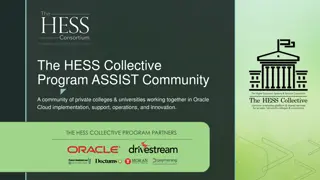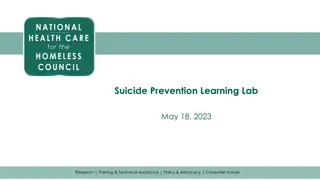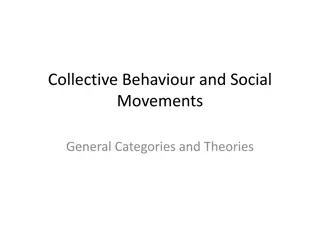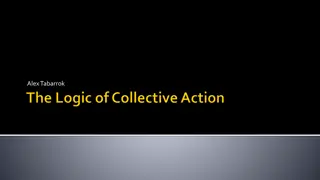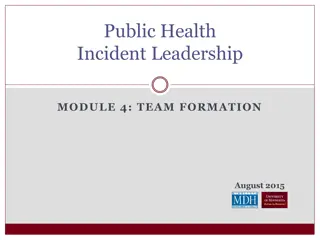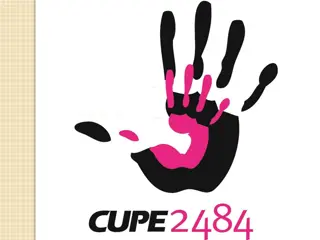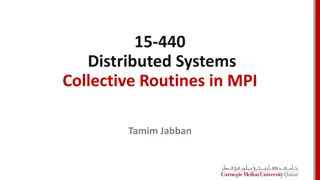Orienting to Results & Collective Efforts
Recommendations from the 2016 Governor's Prescription Drug Abuse Summit in Nevada focused on collective efforts to tackle the crisis. Strategies in treatment options, prescriber education, data collection, and criminal justice interventions were highlighted. Cross-cutting themes emphasized data-driven decision-making and public awareness. The summit proposed enhancing infrastructure, education, data systems, funding, policy changes, and collaboration to address the issue effectively.
Download Presentation

Please find below an Image/Link to download the presentation.
The content on the website is provided AS IS for your information and personal use only. It may not be sold, licensed, or shared on other websites without obtaining consent from the author.If you encounter any issues during the download, it is possible that the publisher has removed the file from their server.
You are allowed to download the files provided on this website for personal or commercial use, subject to the condition that they are used lawfully. All files are the property of their respective owners.
The content on the website is provided AS IS for your information and personal use only. It may not be sold, licensed, or shared on other websites without obtaining consent from the author.
E N D
Presentation Transcript
Orienting to Results & Collective Efforts Working as a State to address a complex problem Sharing a summary of the recommendations by the 2016 Summit by Track
Governors Prescription Drug Abuse Summit Held in August, 2016 2-Day Event Over 450 persons from across the Nevada attended to inform strategies and recommendations
Recommendations Made in Four Interrelated Tracks Track 2: Treatment Options & Third-Party Payers Track 1: Prescriber Education & Guidelines Track 3: Data Collection & Intelligence Sharing Track 4: Criminal Justice Interventions
Collective Impact: 5 Essential Elements Common agenda Shared measurement Mutually reinforcing activities Continuous communication Backbone support
Summit Cross Cutting Themes 1. Design and Implement Data Driven Collaborative Systems for Decision-Making to Address the Crisis 2. Implement Public Awareness to Educate, Inform, and Engage the Public, Prescribers, Physicians, and Community- Based Organizations About the Crisis 3. Ensure Sufficient Infrastructure and Resources to Address the Crisis
How We Will Get There: Recommendations from the Summit Enhanced Infrastructure and Resources Education and Awareness Data Driven Systems Funding and Resource Inputs Policy Changes Leveraging What s Working Nationally & In Nevada Collaboration
1 Track 1: Prescriber Education & Guidelines A.Prescribing Guidelines B.Prescriber Education C.Discharge Planning & Procedures D.Oversight of Pain Management Clinics
1A Prescribing Guidelines Components to be included: Utilize CDC guidelines and adapt them to meet Nevada s needs Incorporate close monitoring, and ensure that guidelines extend beyond prescribers to pharmacists Guidelines need to be developed/adopted in alignment with provider competency requirements Examine lessons learned from Washington and other States that have adopted guidelines to determine what limitations and referral practices need to be in place Look at Washington guidelines related to referral practices
1A Prescribing Guidelines Adoption of prescribing mandates: The adoption of prescribing guidelines needs to support rather than supersede the clinical management of individual patients Patient needs related to pain management and addiction treatment need to be distinct in the way they are described, defined and treated Medicaid, MCO s and third party payers need to be actively involved in implementation design
1A Prescribing Guidelines Considerations need to be made related to multiple facets of a patient s story including stage of life, individual history and circumstance, functioning, and whether pain is acute or chronic Prescribers need reimbursement policies that align with guidelines and allow sufficient time for patient counseling and education Adopted guidelines need to undergo regular revision to remain relevant, evidence-based and responsive to the needs of Nevada s culture Prior to adoption, 100% of licensed prescribers should have the opportunity to review and provide feedback
1B Prescriber Education Prescriber Training: The science behind pain management (including genetic and social influencers) and alternative methods to treatment A hands on approach to integrated care, where pain is viewed in the context of other specialties and other disciplines (psychologists, psychiatrists, social worker) Address provider-patient relationship/communication, including empathy skills Patient assessment/risk assessment
1B Prescriber Education Curriculum and Continuing Education Adoption of a whole person approach: When talking about pain, there is no one size fits all Trauma-informed care Weaning, substitution, effect of age on medications, psychosocial dynamics, appropriateness of medications at various stages of pain management
1B Prescriber Education Curriculum and Continuing Education o Need curriculum and CME based on CDC guidelines/NV guidelines to be adopted o Evidence-based education/training guidelines need to be uniform across related disciplines Implementation of the (ECHO model ) hub- and-spoke knowledge-sharing network and learning community to educate and support clinicians to provide excellent specialty care to patients in their own communities
Discharge Planning and Procedures 1C Adopt a multidisciplinary approach to discharge planning that includes social workers, RNs, and referral providers Initiate MAT prior to discharge, as appropriate Define the role of pharmacists in discharge plan, following 2015 guidelines of the College of Psychiatric and Neurologic Pharmacists Ensure that behavioral health issues are assessed and addressed in discharge plan
Discharge Planning and Procedures 1C Ensure that ER providers and staff have up-to-date resource information for warm-hand offs to supportive services Provide overdose death and hospital data back to the prescribing clinician (link PDMP to hospital and death data) Ensure that information needed for successful transitions in care is provided, including Naloxone administration and response, and collateral information from involved by-standers Electronic bed capacity inventory for referral/transfer to SUD/BH treatment
Discharge Planning and Procedures 1C EMS and criminal investigation teams that respond to an overdose: oImplement overdose response teams that work in partnership with recovery communities Use PDMP to flag patients who have been treated for overdose
1D Pain Management Clinics No consensus on how pain management clinics are, and should be, defined. Consensus on these recommendations: Involve medical board, pharmacy board, and other prescriber licensing boards to determine how pain clinics are defined Tie oversight to non-punitive education on guidelines for all prescribers and staff Incorporate review of how pain management specialists classify themselves in terms of board certification in the oversight process
2 Track 2: Treatment Options & Third Party Payers A. Opioid Management B. Coverage for Non Opioid Pain Management Therapies C. Early Intervention D. Overdose Education & Naloxone Distribution
2A Opioid Management Unprecedented access to prescription drugs has led to an increased need for medication assisted treatment through opioid treatment programs. Nevada should adopt guidelines for comprehensive opioid treatment management across all payers Guidelines should be developed by reviewing what other states/systems have already developed around this issue and creating a customized version for Nevada Guidelines should be established by a multidisciplinary team
2A Opioid Management Address Medicaid Barriers Billing for MAT is sometimes problematic as there are not clearly understood billing codes Develop a Medicaid approved provider options in rural parts of the state Reduce payment and administrative barriers to Medicaid
2A Opioid Management Address Access Barriers Expand access to MAT within the criminal justice field (institutions, parole, and after-care settings), including providing support to those that are homeless Utilize existing policies (ex: suboxone waiver) to expand access to MAT this will require outreach to qualified providers and revised payment structure Eliminate barriers such as fail first
2A Opioid Management Address Access Barriers Address workforce shortage issues (especially in the rural areas) and expand alternative service options such as telemedicine and mobile units Ensure patient centered care which allows the full range of service options to meet each patient s needs Incentivize care coordination through appropriate payment structure
Non-Opioid Treatment Management 2 B A wide range of non-opioid treatment options* should be made available to meet the unique needs of each patient. If forced to prioritize therapies, options which should be offered include: o Chiropractic o Acupuncture o Cognitive Behavioral Health Each of these therapies should be clearly defined to communicate what kinds of care within each therapy are covered Therapies offered should be supported by evidence-based results of success *15 options identified at the summit
Non-Opioid Treatment Management 2 B Enhance provider education, training and experience which would support non-opioid treatment delivery Behavioral Health Providers need to understand the role they could play in pain management services Physicians need to know what non-opioid pain management services exist and how to connect patients to those resources Address the dis-incentives associated with physicians prescribing non-opioid treatment options (disposition of clientele, client dissatisfaction, time associated with treatment option which is not adequately reimbursed)
2 B Non-Opioid Treatment Management Increase educational component to training/licensing about the variety of therapy options available which support pain management Need to develop a multidisciplinary team to support Medicaid and solution implementation Need to address compounding treatment/recovery factors such as housing and transportation
2 C Early Intervention Expand Use of SBIRT among providers and with complimentary professionals Encourage/require physicians issue screenings Embed screenings into electronic health records and provide training to support utilization Pharmacist directed SBIRT Establish a statewide forum for sharing best practice information on SBIRT and integrated care
2 C Early Intervention Use behavioral health tele-medicine within primary care settings/clinics who can conduct SBIRT and other behavioral health services Address federal regulations that limit communication efforts between behavioral health and primary health care professionals Resource directory geared towards health professionals about community resources available to patients (Healthiernv.org) Look at IMPACT model out of University of WA
2 C Access to Care Expand telemedicine options Address transportation barriers Case coordination needs to be provided as a component of comprehensive care. Peer leadership models also promote access to care Partner with existing providers (trusted community resources like schools) to act as an access point
2 C Access to Care Partner (with Universities) to secure resources and implement mobile services in rural areas Examine Rural Veteran s Programs in Oregon and Washington as potential models for increasing access to care in rural areas Use of community health workers as a component of care
Overdose Education & Naloxone Distribution 2D Reach priority groups for education and distribution Expand access to Naloxone: o Make multiple naloxone doses available to individuals who have been prescribed Naloxone so that multiple family members have it available. o Enable over the counter access to anyone wanting Naloxone. o Ensure that treatment providers have access to Naloxone (homeless/substance abuse programs) Ensure training and education is available to everyone who may administer naloxone.
Track 3: Data Collection & Intelligence Sharing 3 3 A. Prescription Drug Monitoring Program B. Empowerment of Nevada's Occupational Licensing Boards C. Law Enforcement Data Sharing D. Public Health Data
3 A PDMP Ensure Health Insurance Portability and Accountability Act (HIPAA) compliance between data systems Ensure a mechanism for State Boards to report back to PDMP Facilitate access to lock in health plans Mandate providers receiving state dollars sign up to submit data in PDMP and make this a requirement of licensing Evaluate requiring a second signature for prescription/pain specialists/behaviorists
Empowering Licensing Boards 3 B Boards all agree they need to do more and have been working more collaboratively. They are crafting language for a bill draft and need Legislative support to: Shorten the time frame to obtain records and lengthen check in to a 60-day dispensing license Facilitate access to medical records for investigation
Empowering Licensing Boards 3 B Address the issue of phantom prescribers, who are licensees not on the books Boards will engage in a unified public awareness campaign general public, practitioners, and pharmacists The Boards have agreed to a website for anonymous complaints about prescribers or any health care practitioner Identify trends, doctor shop by using PDMP
Data (Joint Session on Law Enforcement Data Sharing) 3 C Use a Fusion Center to model reports using de- identified data on trends (Look at New Hampshire model for their partnership with public health, law enforcement, etc.) Create centralized data center with the technical expertise and resources for analyzing and extracting information specific to the partners /communities needs. Ensure data is complete, accurate, and useful, adheres to HIPAA and other privacy standards
Data (Joint Session on Law Enforcement Data Sharing) 3 C Use data to drive policy and resource decisions; and help direct investigations. Data includes: Addiction analysis data Prescriber/payer data Coroner data re: over dose deaths Examine what the Drug Enforcement Administration (DEA) is doing in Clark County and expand it statewide.
Data (Joint Session on Law Enforcement Data Sharing) 3 C Utilize coroners, PDMP, and Public Health as a starting place to establish an agreement for data sharing Improve timeliness and distribution of data (e.g., death records, hospital over doses, Emergency Medical Services/Fire data re: overdoses and naloxone distribution, etc.) Add local health departments into the information sharing partnerships
3 D Public Health Data Evaluate feasibility of implementing a dashboard (in development through DPBH) There is a need for both identified and de- identified data and agreements about how data is collected and reported Work with coroners to improve the reporting their data related to overdoses Collect data from PDMP, and Public Health including local health districts and workforce data Use predictive analytics for best practice identification and public education
3 D Public Health Data Promote use of the Health Insurance Exchange (HIE) to obtain more/better data with greater participation Integrate data system and reporting consistently, so data sets ask the same question across multiples systems Use memorandums of understanding (MOU) to put formal data sharing agreements into place Utilize shared resources across state systems to strengthen data collection and sharing Allow access for research and evaluation
Track 4: Criminal Justice Interventions 4 A. Deterrents for Criminal Activity B. Prescription Drug Disposal C. Law Enforcement Data Sharing D. Sequential Intercept Model
4 A Deterrents for Criminal Activity Amend Nevada Statute to mimic federal thresholds for trafficking Schedule 1 substances Lower thresholds for determining felony classes (suggested levels: 4 to less than 12 grams C felony, 12- 28 grams B felony, 28 grams or more A felony) In addition to changes in weights, determine number of pills and lowered pill quantity
4 A Deterrents for Criminal Activity Expand penalties conspiracy is a C felony and considered too low Enhance penalties for medical/other professional provider convicted of crime [related to opioids] Allow aggregation in order to demonstrate/prosecute conspiracy; expand penalties for conspiracy
4 A Deterrents for Criminal Activity Suggested approaches to expand law enforcement partnerships and data access to better target over-prescribers, traffickers/criminal include: o Develop policies and procedures for using PDMP database to send alerts and help investigate overprescribing. Could use National Crime Information Center (NCIC) policies/procedures as example o Add state and local partners to participate on the DEA task force to connect cross state trafficking
4 A Deterrents for Criminal Activity Suggested approaches to expand law enforcement partnerships and data access (con t) o Build on and formalize partnerships between agencies, provide a single point of contact for each agency. Use the High Intensity Drug Trafficking Area program (HIDTA) framework. Formalize how executive supervisors communicate
4 B Drug Disposal Nevada has a robust year-round prescription drug take back program that is run through the State s many prevention coalitions. Nevada has struggled to find a sustainable solution for prescription drug disposal There was agreement that Nevada should adopt a statewide strategy for sustainable, effective drug disposal A variety of disposal options and suggested policies and practices were outlined for future evaluation
Law Enforcement Data Sharing 4 C Covered under Track 3: Data Collection and Intelligence Sharing
Sequential Intercept Model (SIM) 4 D Promote successful implementation of SIM Leverage Certified Community Behavioral Health Clinics (CCBHCs) Leverage presumptive eligibility opportunities for enrollment and Targeted Case Management (TCM) Certified peer mentors/navigators
Thank You! More Information about the Summit: http://gov.nv.gov/uploadedFiles/govnvgov/Conten t/News_and_Media/RX/FinalSummitReport.pdf Contact Information Social Entrepreneurs Inc. 775.324.4567 Project Contact: kmarschall@socialent.com or sboxx@socialent.com


